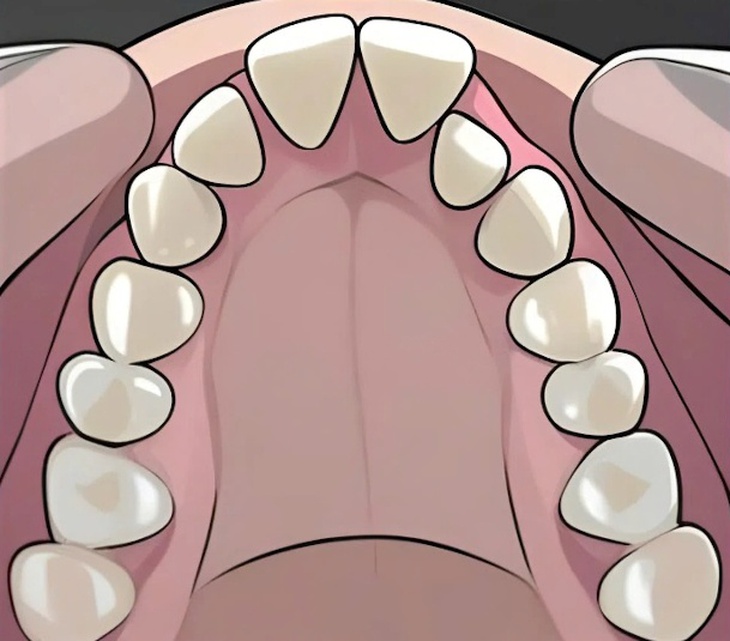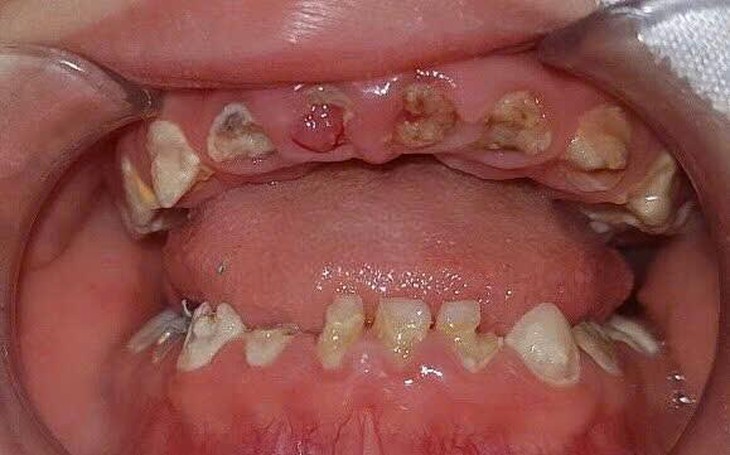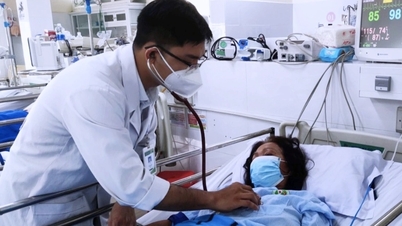
The palate can develop into a V shape in bottle-fed babies - Illustration photo
Craniofacial growth is 90% complete by the age of 12, with maximum growth occurring within the first four years. During breastfeeding, the tongue pushes the soft breast tissue against the palate with gentle, steady pressure, causing a gradual, uniform change in the palate, which facilitates normal growth of the gums and subsequent eruption of the teeth.
The palate is very flexible, all objects coming against it regularly will cause it to develop spontaneously.
When breastfeeding, the baby's mouth is compressed by the surrounding breast, causing the dental arch to develop in a U-shape. While bottle-feeding, the bottle nipple is much harder and smaller than the mother's breast, causing the palate to develop in a V-shape instead of the normal U-shape. This deformation prevents proper tooth eruption and causes bite deformities.
For bottle-fed babies, the difference is that there is no milk secretion from the mammary glands, but the baby has to exert a force on the tip of the rubber teat with the tongue resting against the upper gum line. The forward and backward movement of the tongue will push the milk along and out of the teat.
Bottle feeding does not help the lips close, does not facilitate nasal ventilation, does not help the tongue and lower jaw to move forward, and has limited development of muscles such as the tongue muscle, lower jaw protrusion muscle, and lower lip orbicularis oculi muscle.
When bottle-feeding, the baby only puts the lower jaw forward minimally because the pacifier is usually more conical than the mother's nipple, the bottom of the oral cavity does not close tightly because the chewing muscles are less active, the tongue will compress the pacifier and rest on the palate with a piston-like compression motion, this force always acts on the same area and the same axis, so it deforms the palate, making the palate deeper, reducing the volume of the nasal cavity.
At the same time, the cheek muscles create a large force to increase the pressure in the mouth, changing the alveolar crest, milk flows continuously because the oral cavity is not closed, creating favorable conditions for mouth breathing or easily causing obstructive sleep apnea syndrome.
Does bottle feeding affect dental development?
Consequences on the bite
Anything that enters the mouth of a nursing baby will impact the development of the craniofacial structures. The extent of this impact depends on the timing, frequency and duration of each introduction. Soft breast tissue adapts easily to the baby's mouth, harder objects will create an oral adaptation.
Many studies show that bottle feeding not only causes tooth decay but also causes more malocclusion than breastfeeding. The most common malocclusion problems are anterior open bite and posterior cross bite.

3-year-old child, has the habit of drinking from a bottle at night, has many cavities, and severely damaged tooth tissue - Photo: BSCC
Breastfeeding cannot prevent the occurrence of Class II malocclusion and mandibular regression. However, bottle and pacifier use carries a high risk of malocclusion, especially in cases where bottle feeding is continued after 24 months of age.
In cases of palate deformities, such as deep palate due to poor tongue mobility, restricted nasal airways facilitate mouth breathing and sleep apnea.
In addition, low position of the tongue, as well as malocclusion, can lead to pronunciation disorders.
Consequences on the function of the masticatory muscles
Studies have shown a clear difference in the development of cheek muscles in breastfed and bottle-fed babies: Breastfed babies have longer suckling cycles, which is important because the longer the suckling cycle, the greater the impact on maxillofacial development. The intensity of sucking movements in breastfed babies is also greater. In bottle-fed babies, there is a clear reduction in masseter muscle activity.
Effects on upper airway development
The development of facial structures depends on the development of the nasal cavity. Any abnormalities of the palate will have a serious impact on the upper airway. Studies have shown that the distortions caused by the use of baby bottles with pacifiers are a high risk factor for obstructive sleep apnea.
Obstructive sleep apnea is a serious medical problem that affects the ability to breathe during sleep.
During breastfeeding, the pressures caused by sucking on the breast play an important role in the optimal development of the facial structures: palate, jaw bones… Bottle feeding, regular use of pacifiers, thumb sucking do not create adequate pressures as above, increasing the risk of malocclusion and abnormal development of bone structures, contributing to the development of obstructive sleep apnea.
Extraoral disorders
- Air swallowing and reflux: when bottle-feeding, milk flows out of the bottle and there is air penetration, not lasting as long as breastfeeding. This activity often happens quickly and roughly, so the stomach due to drinking milk and swallowing air during feeding affects digestion, often causing nausea and vomiting.
- Psychological impact: When bottle-fed, babies drink faster, so breastfeeding does not meet their needs, and is compensated by sucking fingers or pacifiers, creating conditions for bite misalignments.
- Risk of otitis media.
Breastfeeding not only nourishes the baby but also provides natural "functional exercise"
This helps the palate develop in a U-shape, facilitating nasal breathing and harmonious craniofacial development. Prolonged bottle feeding with an inappropriate nipple can create a "piston"-like concentrated force on the palate, resulting in a narrow, deep palate, increasing the risk of posterior crossbite/anterior open bite and mouth breathing.
Early malformations of the palate and dental arch are closely related to the airway, increasing the risk of snoring and sleep apnea in children. Parents can reduce the risk by prioritizing breastfeeding, choosing soft, slow-flow nipples if bottle-feeding is required, weaning off pacifiers early, practicing age-appropriate chewing and regular dental check-ups.
When you notice your child is mouth breathing, snoring, sleeping restlessly, has crowded teeth or a misaligned bite, take your child to the dentist for timely advice and intervention.
Source: https://tuoitre.vn/nhung-anh-huong-toi-rang-xuong-ham-gia-dinh-co-tre-bu-binh-can-biet-20250929091956795.htm



![[Photo] Binh Trieu 1 Bridge has been completed, raised by 1.1m, and will open to traffic at the end of November.](https://vphoto.vietnam.vn/thumb/1200x675/vietnam/resource/IMAGE/2025/10/2/a6549e2a3b5848a1ba76a1ded6141fae)











![[Video] Ministry of Health issues document to rectify medical examination and treatment work](https://vphoto.vietnam.vn/thumb/402x226/vietnam/resource/IMAGE/2025/10/2/54913f30a9934e18bcbb246c2c85f11d)



















































































Comment (0)